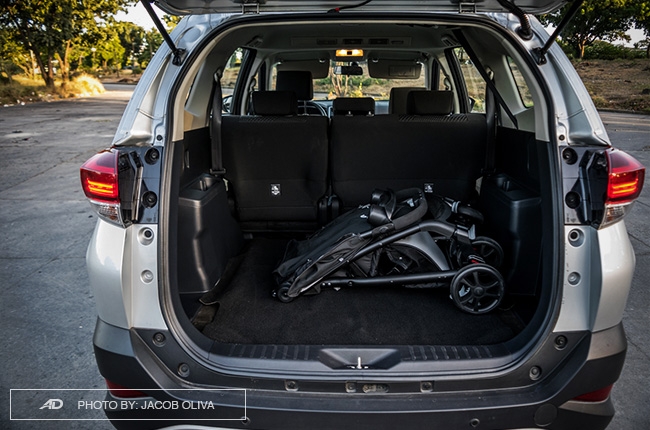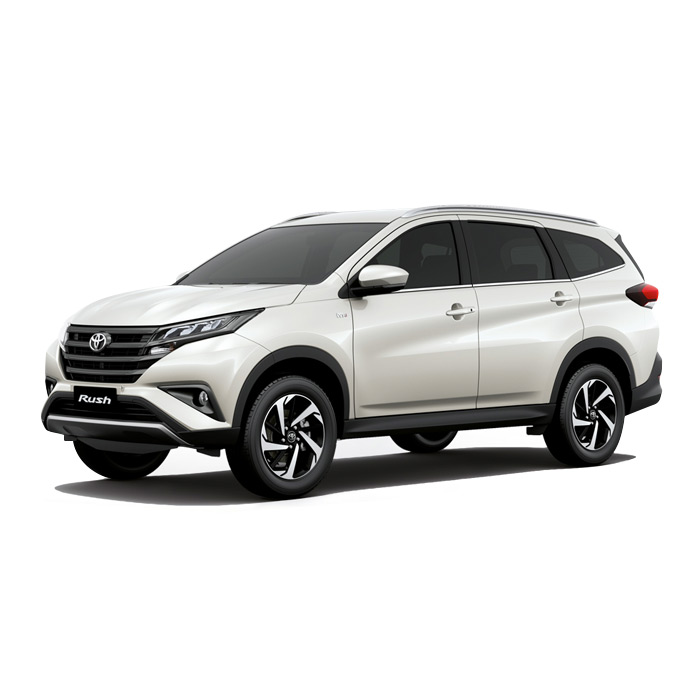
When I reviewed both the 7-seater and 5-seater 2018 Toyota Rush variants, there’s quite a major difference between the two that could easily affect the decision of car buyers. It’s actually a question of usage: am I going to load more things in the trunk rather than ferrying people?
If you’re in this same dilemma right now, that’s the question you have to answer, and but one that can easily be answered, especially that there are only a few things you should sacrifice when going for the more affordable 5-seater variant.
We’ve seen the 5-seater Rush E in full view in our in-depth review. Now let’s take a closer look at its interior amenities and cargo space that I’ve been raving about.
Same Cabin Amenities
In all the Rush offerings, you’ll be greeted with the same cabin material. That means shower of hard plastics populates the interior, along with piano black accents and satin chrome. The white faux-leather with fake stitches is also kind of a downer, too. We can’t blame Toyota for that; the company has to compensate to bring you a good-looking exterior for its entry-level SUV.
With these similarities, even the lot of cubby holders, cupholders, and bottle holders in the entire cabin is present. That’s seven in the front, four in the second row, and two at the back – yes, for some reason there are cupholders on the supposedly third row even with the absence of seats. A bit absurd, but it is what it is.
Now, the seats are clad with fabric – a soft textured one, for that matter. It’s similar to what the Vios and the Yaris have which means it feels good to the touch but it’s kind of dirt- and dust-magnet, so there’s that.
My only problem with the Rush’s interior is its non-telescopic steering wheel. It’s challenging to find a comfortable driving position for me, which is quite essential if you’re driving it for a long haul. The polyurethane steering wheel material is also a bit firm; it kind of spoils the pleasure you wanted to feel when driving.
More Space, More Flexibility
The main advantage of the 5-seater over the 7-seater is the tremendous amount of cargo space that’s made available with the absence of the last row. While the seven-seater can house 214L of cargo, the 5-seater has double. Actually, more than double, totaling to 514L. Even with all the seats erect, it could fit a standard child stroller and two-month worth of groceries, and actually more when you fold and stumble the second row. The whole cargo area is flat, as well as the lip, so cargo loading and unloading are painless.
I also noticed that you can slide the second-row seats forward, which adds to the overall flexibility of the car. With the Rush’s P988,000 price tag, it can easily go head-to-head with the subcompact crossovers out there, but with more interior space that’s built on top of a body-on-frame chassis and rear-wheel drivetrain. It’s a good value proposition, especially if it’s practicality that you’re looking for.
Toyota Rush 5-Seater Interior Gallery
Specifications
Engine
1.5 LFuel Type
GasolinePerformance
102 hp @ 6,000 rpmTransmission
Automatic-
Summary
-
Name Toyota Rush 1.5 E AT Body Type MPV Price ₱1,052,000 Transmission Category Automatic -
Engine
-
Engine Size 1.5 L Displacement 1,496 cc Number of Cylinders 4 Number of Valves 16 Transmission Type 4-Speed Automatic -
Performance
-
Drivetrain Rear-Wheel Drive Max Output (hp) 102 hp @ 6,000 rpm Max Torque (nm) 134 Nm @ 4,200 rpm -
Economy & Environment
-
Fuel Type Gasoline Emissions Standard n/a Fuel Capacity 45.0 L *Combined Fuel Consumption 8.27 km/L *brand manufacturer claim
-
Dimensions
-
Length 4,435 mm Width 1,695 mm Height 1,705 mm Wheelbase 2,685 mm Turning Circle 10 m Ground Clearance 220 mm Trunk Capacity 220 L Number of Doors 5 Number of Seats 7 -
Safety & Security
-
Driver's Airbag 1 Front Passenger's Airbag 1 Side Airbag 2 Curtain Airbag 2 Knee Airbag Auto Brake System Electronic Brake Distribution Anti-lock Brake System (ABS) Anti-lock Brake System with Electronic Brake-force Distribution
Immobilizer Security Alarm Stability Control Electronic Door Locks Speed Sensing Door Locks ISOFIX Lane Departure Warning System Blind-Spot Detection System -
Features
-
Cruise Control Front Parking Sensors Rear Parking Sensors Leather Upholstery Push Start Button Wheel Size 16 in Wheels Metal Type Alloy Airconditioning System Auto A/C Entertainment System Touch Screen 7" Display Audio with CD and MP3 via 6 speakers Connectivity Aux, USB, and Bluetooth w/ Weblink Connectivity for iOS and Android Navigation Ready Warranty 3 Years (100,000 km) Keyless Entry Roof Rack Sunroof Electric Adjustable Seats Power Steering Power Windows Power Outlet Steering Wheel Audio Control -
Technology
-
Active Park Assist Hill Start Assist AWD Modes n/a Tire Pressure Monitoring Heads-up Display Power Liftgate Start-stop System
Colors
Latest Review
-
2026 Hyundai Creta N-Line Review / Review
The Creta N-Line isn’t just a Creta with sporty looks; it’s got the performance and bite to back up its style.
4.3 / 5 -
2026 BYD Shark 6 DMO Review / Review
Can a hybrid pickup truck break the mold of what pickup trucks can be? The Shark 6 DMO has something to say about that.
4.6 / 5 -
2026 Hyundai Elantra N-Line Review / Review
The Elantra N Line isn’t as hot as the N, but can it still deliver the sporty sedan thrill we seek? We find out.
4.2 / 5
Popular Articles
-
Electric Vehicles in the Philippines for under P1 million
Jerome Tresvalles · Aug 19, 2025
-
Top 3 Cars For Every Lifestyle—What Cars Are Right For You? | Behind a Desk
Caco Tirona · Apr 24, 2024
-
5 Tips to Maximize Fuel Efficiency
Jerome Tresvalles · Sep 09, 2024
-
Five driving habits that are draining your fuel tank
Jerome Tresvalles · Jun 24, 2025
-
Can engine braking harm your engine?
Jerome Tresvalles · Sep 11, 2025
-
Do electric cars even need maintenance?
Jerome Tresvalles · Oct 23, 2024
-
Best vehicles for an active outdoor lifestyle
Shaynah Miranda · Jul 25, 2024
-
How to drive different types of vehicle transmissions
May 23, 2024
-
5 easy ways to keep your car interior clean
Allysa Mae Zulueta · Nov 15, 2021
-
How to survive Metro Manila traffic
Earl Lee · Aug 16, 2022


















